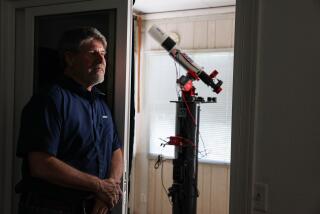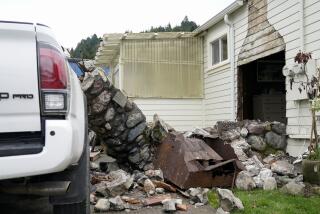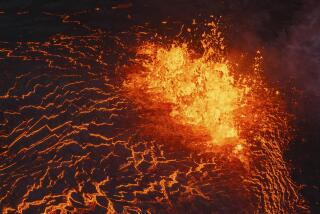Seismologists Raise Alert Level for the Quaking Mt. St. Helens
- Share via
SEATTLE — Mt. St. Helens, the volatile mountain that blew its top in spectacular fashion 24 years ago, has been grumbling again, and scientists said Wednesday that a small to moderate eruption was possible in the next few days.
Such an event could spew rock and ash thousands of feet in the air, but the fallout probably would not go beyond the volcano’s crater or flanks. At worst, scientists say, some debris could travel as far as three miles -- nowhere near the closest towns of Cougar and Toutle.
Seismologists monitoring the volcano, which is about 100 miles south of here, on Wednesday afternoon raised the alert level to “volcano advisory” -- level 2 on a three-step scale -- after a series of small earthquakes indicated the mountain was, in the words of local seismologist Seth Moran, “ramping up.”
Moran said a hardened dome of lava inside the crater also appeared to be growing, which meant that gases or molten rock could be building just below the surface. The lava dome, now about 900 feet tall, grew inside the crater in the years after the May 18, 1980, eruption that killed 57 people and razed more than 150 square miles of forest.
The eruption blew off the top 1,300 feet of the mountain and caused one of the largest recorded landslides in history. Ash from the explosion eventually circled the globe.
That type of eruption “is not in the cards this time,” said Steve Malone, a seismologist at the University of Washington. But, Malone and other scientists added, predicting volcanic eruptions is not an exact science; it’s possible the eruption could be bigger than expected, or it may not happen at all.
“We’re not guaranteeing an eruption,” said Cynthia Gardner, a research geologist for the Cascades Volcano Observatory in Vancouver, Wash. The observatory is operated by the U.S. Geological Survey.
The U.S. Forest Service has closed hiking trails near the crater and above the 4,800-foot level of the mountain, which is 8,364 feet high. The Weyerhaeuser Co., which owns 435,000 acres surrounding the mountain, closed off areas within a 12-mile radius of the volcano.
Since 1980, Mt. St. Helens has experienced three minor -- and largely ignored -- explosions. A larger one occurred in 1986 after pressure under the lava dome burst. Scientists say the volcano’s current buildup resembles the one in 1986.
On Sept. 23, instruments began detecting intermittent swarms of earthquakes beneath the crater; by Tuesday, the quakes -- the largest measuring between 2 and 2.8 -- were coming at a rate of two to three per minute.
“Most of these earthquakes are very, very small. You wouldn’t feel them even if you were standing right on top of them,” Moran said.
After a quiet period Tuesday evening, the quakes began again early Wednesday and lasted nearly eight hours, Moran said during a briefing in Vancouver. He said the swarms were accelerating “in both frequency and intensity.” During that period, instruments recorded up to four quakes per minute.
Scientists have been making daily helicopter trips to the top of the mountain since Monday, trying to collect gas samples and planting measuring instruments on the lava dome and on the slopes of the crater. Their main mission is to determine the cause of the quakes and the apparent buildup of the dome. Once they determine this, scientists can better predict what kind of “explosive event,” if any, is likely to take place.
Meanwhile, officials at the Mt. St. Helens visitors center, which has remained open, have reported a noticeable increase in tourists since Sept. 23. Instead of being frightened away, people seem to be drawn toward the volcano.
“There’s nothing more alluring than a volcano, and there’s nothing more alluring than a volcano that looks like it might erupt,” Gardner said.
In the community of Toutle, about 25 miles west of the volcano, it’s been business as usual. “The main thing is to not overreact,” said school Supt. Scott Grabenhorst. He said while residents don’t seem particularly worried, it’s probably a good time to revisit some of the safety drills devised after the 1980 eruption.
In Portland, Ore., which is about 50 miles southwest of Mt. St. Helens, Mayor Vera Katz directed all city bureaus to update their preparedness plans. “The greatest threat to Portland from a major eruption is the ash that in 1980 seemed to cover everything,” Katz said in a statement.
More to Read
Sign up for Essential California
The most important California stories and recommendations in your inbox every morning.
You may occasionally receive promotional content from the Los Angeles Times.










